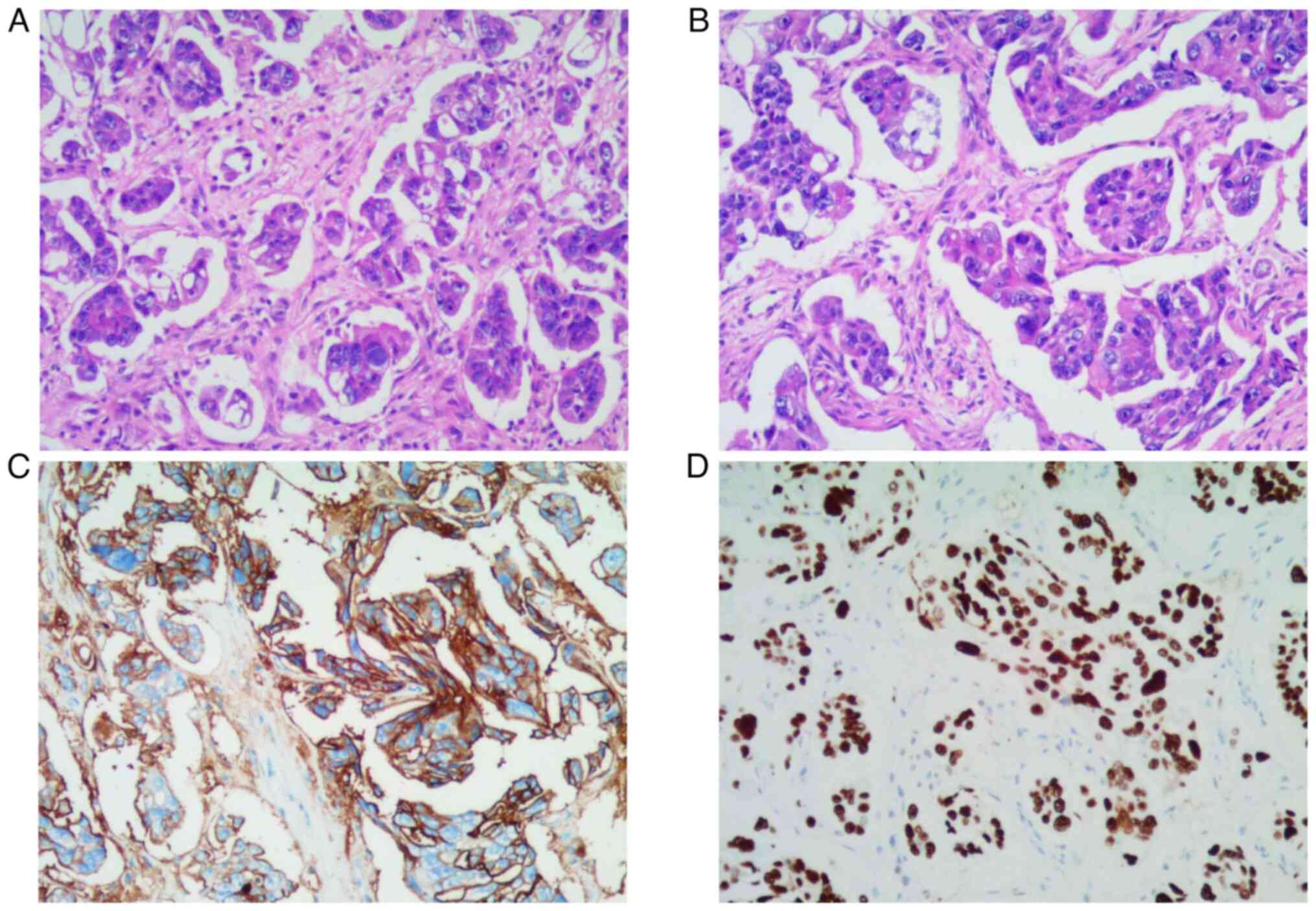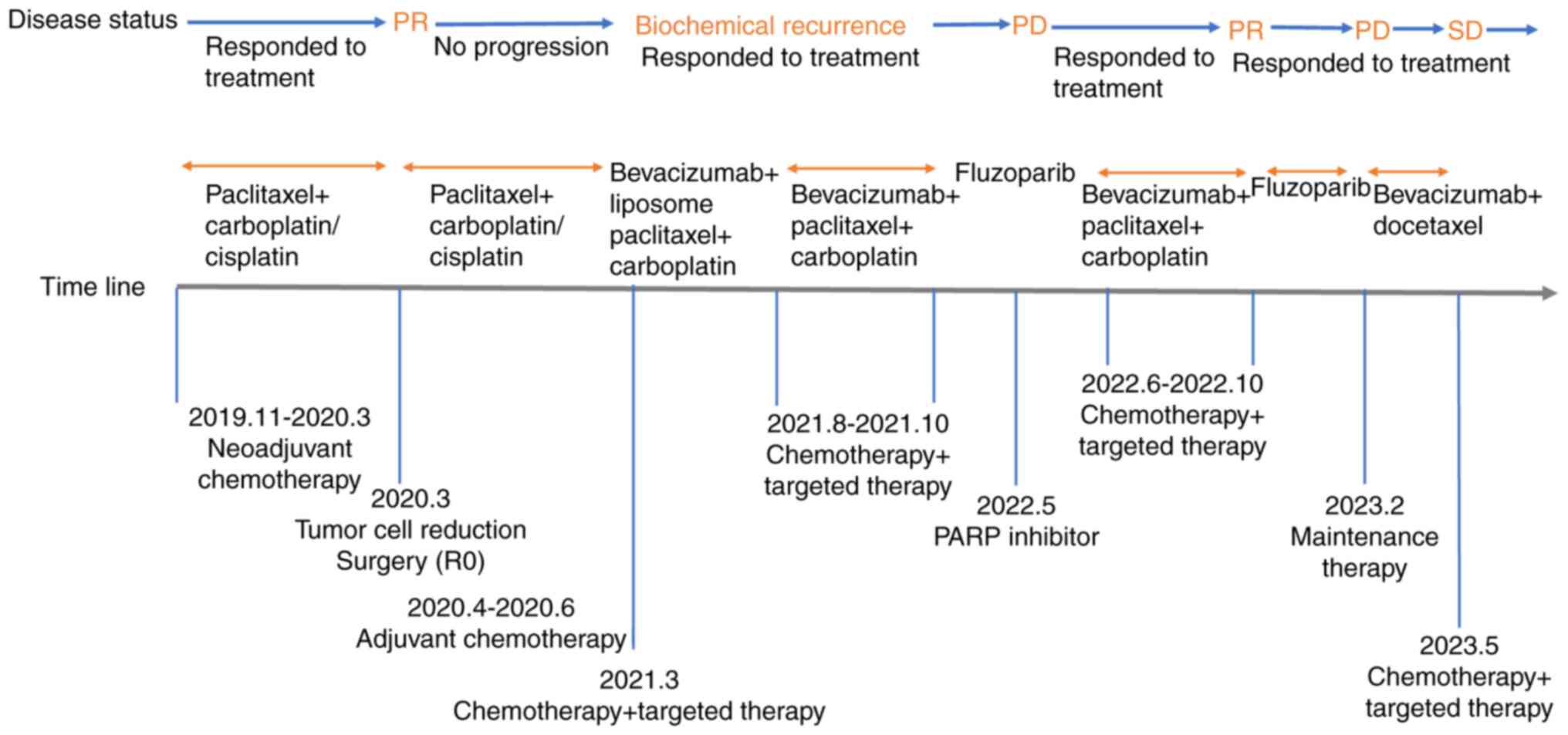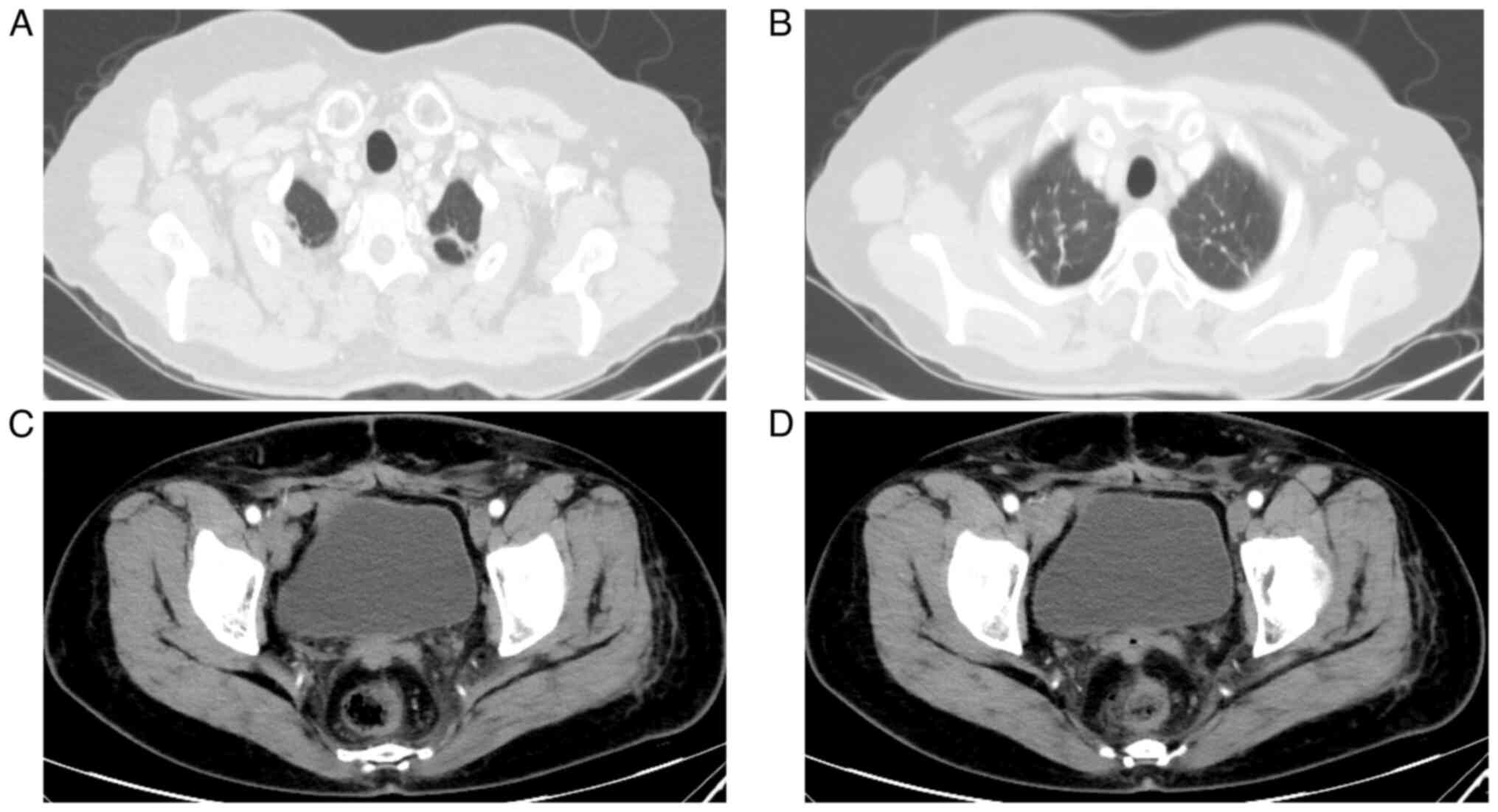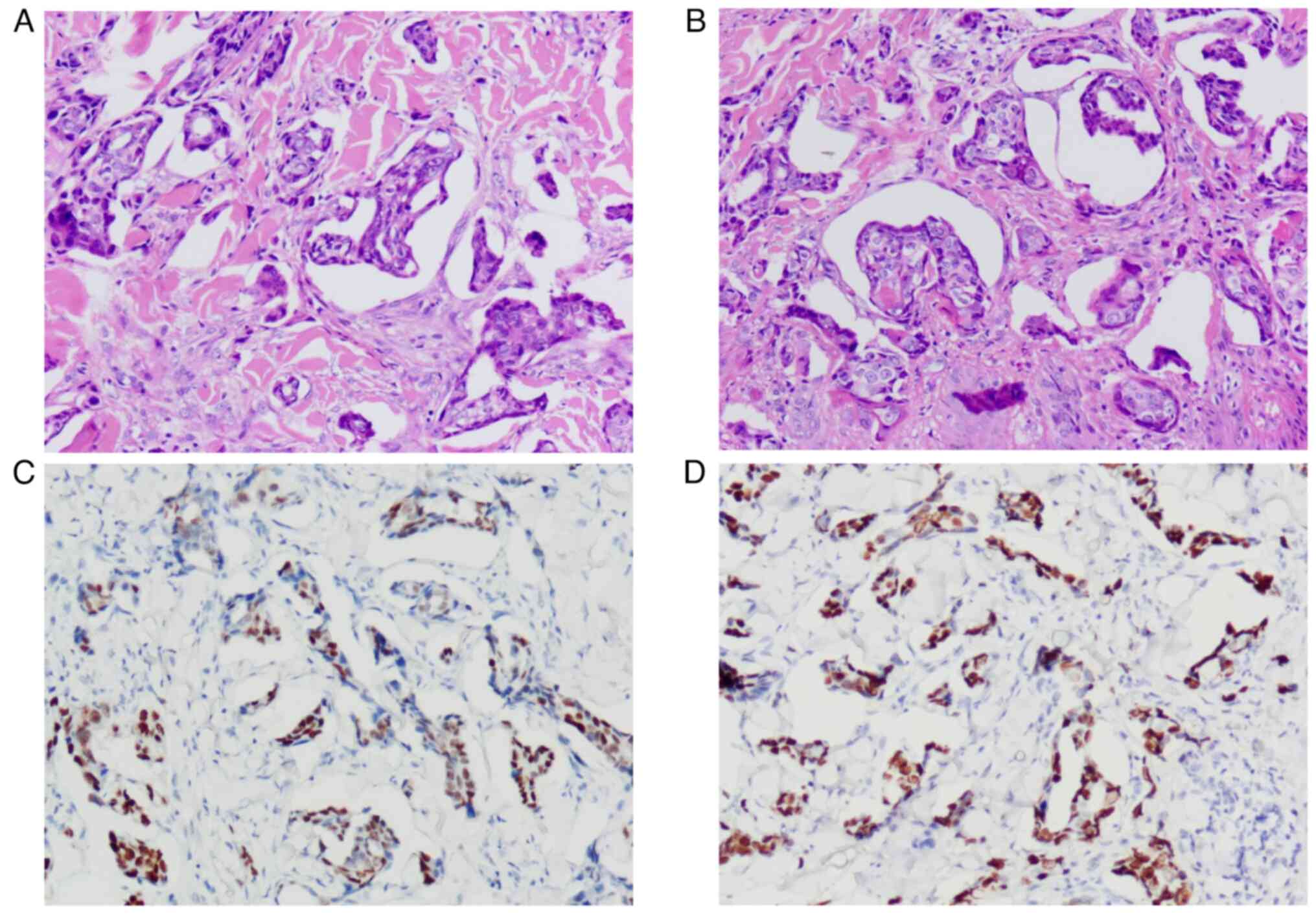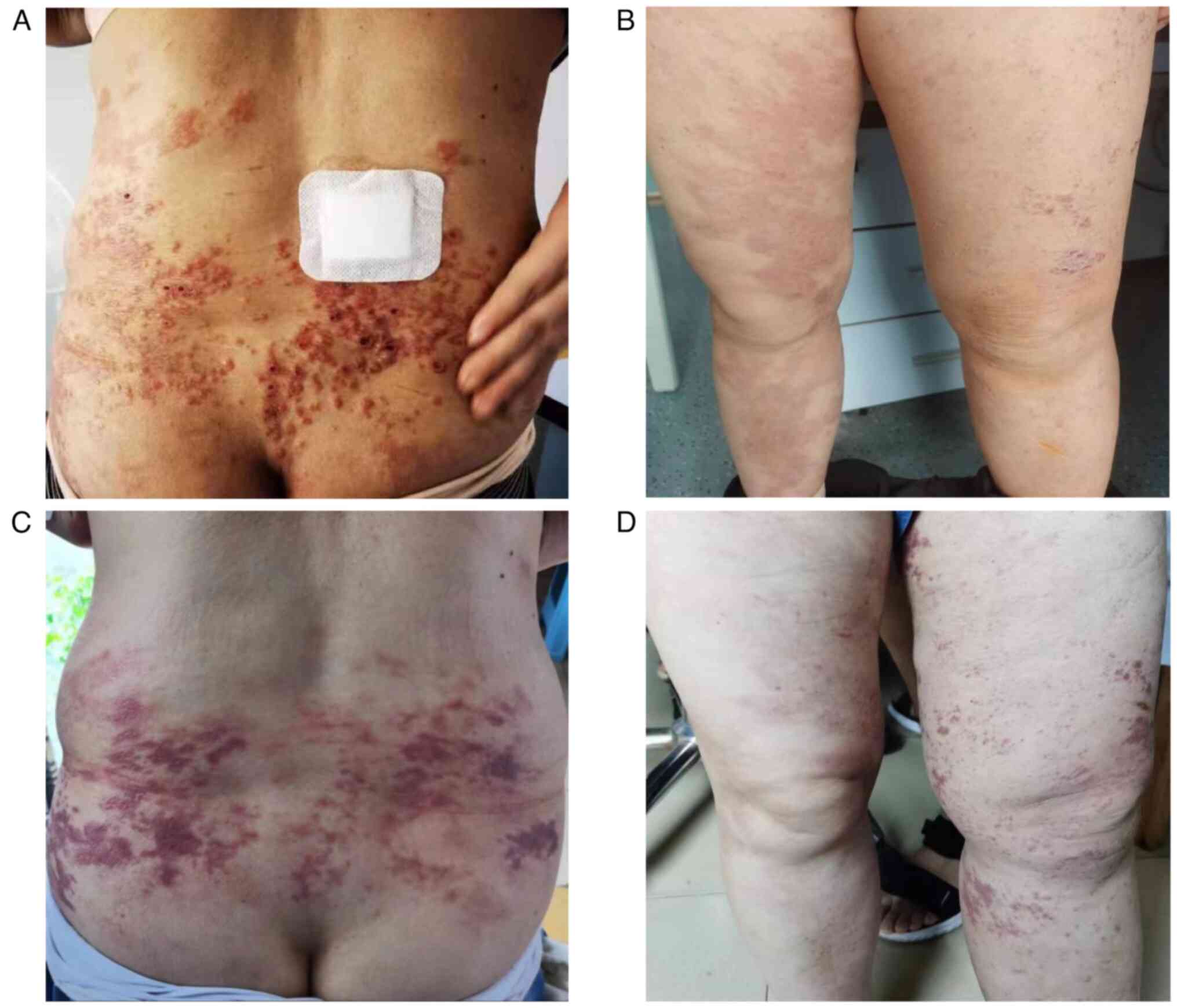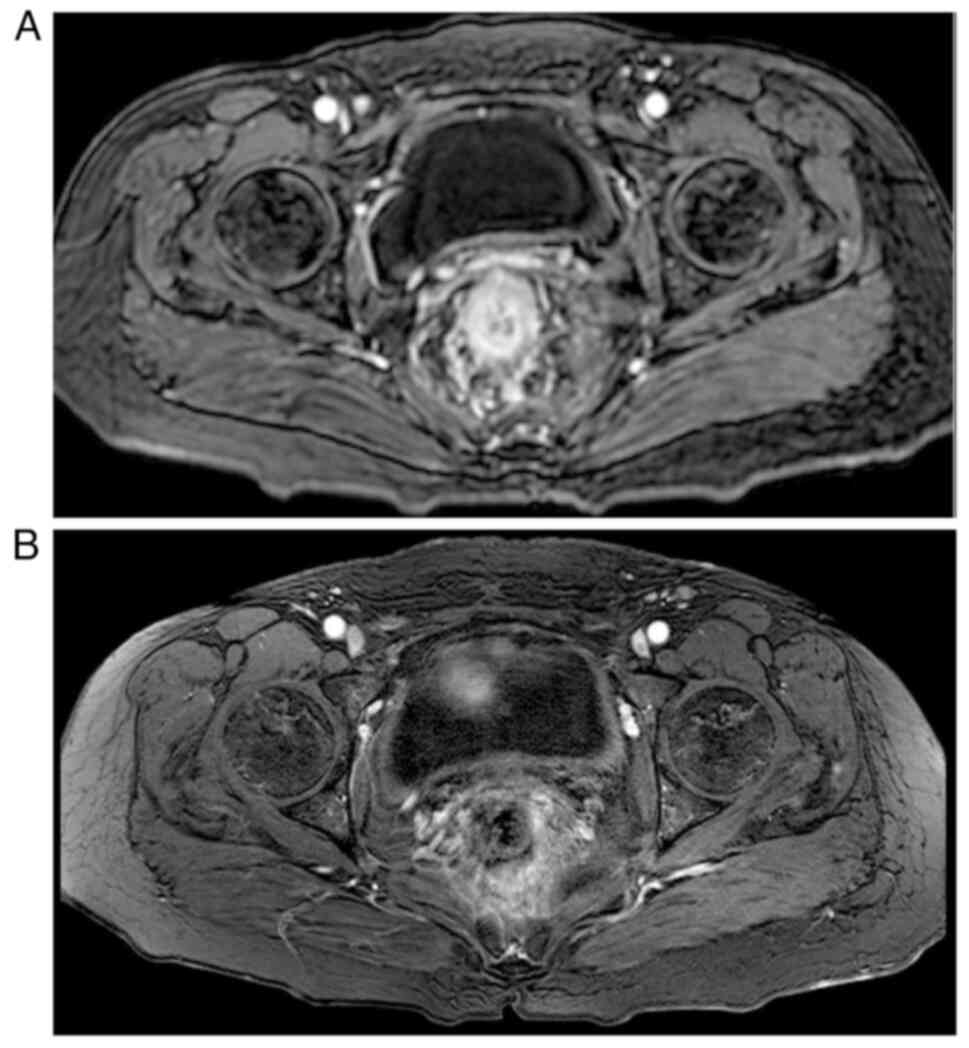Skin metastasis from ovarian cancer with somatic BRCA1 mutation: A case report and literature review
- Authors:
- Published online on: June 3, 2024 https://doi.org/10.3892/ol.2024.14481
- Article Number: 348
-
Copyright: © Zhang et al. This is an open access article distributed under the terms of Creative Commons Attribution License.
Abstract
Introduction
Ovarian cancer is an important cause of gynaecological tumour-related death. Cancer of the ovary, brain, pancreas, oesophagus and stomach had the highest annualized initial treatment costs at ~80,000, 100,000, 90,000, 80,000 and 70,000 dollars, respectively, in the United States in 2010. Conversely, melanoma, prostate cancer and breast cancer had the lowest annualized initial costs at 5,000, 20,000 and 23,000 dollars, respectively. The cost of ovarian cancer can increase to 100,000 dollars in the final year. The financial burden of treatment represented by these costs highlights that early detection and prevention of ovarian cancer is an economic and cost-effective strategy (1,2). Epithelial ovarian cancer occurs through two carcinogenic pathways, type I and type II. Common high-grade serous tumours arising through the type II pathway harbour tumor protein p53 and BRCA DNA repair associated (BRCA) mutations (3–5). Numerous patients are diagnosed with distant metastases when visiting a doctor for unrelated reasons. At present, proteomics techniques, such as mass spectrometry and protein array analysis, play an important role in the diagnosis and treatment of ovarian cancer (6). Common metastatic sites of ovarian cancer include the liver, spleen, lungs, pleura and lymph nodes (7,8). The incidence of skin metastasis in ovarian cancer, including Sister Mary Joseph nodule (SMJN) and non-SMJNs, is low at 0.9–5.8% in specific regions, including the following areas: California, USA; Chiba, Japan; Bari, Italy; Hangzhou, China. SMJNs are more common at the first visit, and non-SMJNs are more common at recurrence, with a median survival of 12 months for both (7,9). At present, the best treatment for skin metastases from ovarian cancer is still unclear. Surgery, radiotherapy, chemotherapy, targeted therapy, immunotherapy and other combined therapies have all been considered. Owing to individual differences, not all patients receive comprehensive treatment. Surgery, chemotherapy and targeted therapy have been found to be effective in extending survival, even in older patients (10,11). The current study presents a case of advanced ovarian cancer with a BRCA1 mutation and skin metastasis, showing the rare clinical manifestation of severe anal distension due to rectal wall thickening, and reporting its response to chemotherapy, angiogenesis therapy and poly(ADP ribose) polymerase (PARP) inhibitors.
Case report
Initial diagnosis and treatment
A 49-year-old woman was admitted to the Affiliated Hospital of Southwest Medical University (Sichuan, China) in November 2019 after finding a navel nodule. Pathological biopsy revealed the nodule to be cancer antigen 125 (CA125)(+) and p53 (+, 90%), as shown in Fig. 1. 4% paraformaldehyde was fixed at room temperature for 24 h, 4 micron thick sections were stained at room temperature, stained with hematoxylin for 10 min, stained with eosin for 1 min, and observed under a light microscope at a magnification of 200 times. IHC details: Tissues were embedded in paraffin, fixed in 4% paraformaldehyde for 24 h at room temperature and sectioned at 4 micron thickness. P53 was 1:500, cat. no. MAB-0674, the dilution ratio of CA125 was 1:500, cat. no. MAB-0830, the supplier was Fuzhou Maisin Biotechnology Development Co., LTD., and the incubation time was 20 min at 32°C, the secondary antibody dilution ratio was 1:500. The cat. no. DS-0003, the supplier was Beijing Zhongshan Jinqiao Biotechnology Co., LTD. (peroxidase/phosphatase), and the incubation time was 20 min at 32°C. The chromogenic detection reagent was EnVision FLEX, High pH (Dako Omnis). The light microscope was used for observation at a magnification of 200. The patient was diagnosed with stage IVB ovarian adenocarcinoma, considering high-grade serous adenocarcinoma of the ovary with navel metastasis. Serum tumour markers showed elevated levels of CA125 (5,304.07 U/ml; reference range, 0–35 U/ml) and human epididymis protein 4 (HE4: 337.80 pmol/l; reference range, <92.1 pmol/l in premenopausal women and <121 pmol/l in postmenopausal women). Two cycles of chemotherapy [paclitaxel (175 mg/m2) on day 1 + carboplatin (area under the curve (AUC)=5) on day 1, every 21 days] were administered from November to December 2019, after which the patient developed grade IV myelosuppression. The patient had a white blood cell count of 0.86×109/l (reference range 3.5–9.5×109/l), a neutrophil count of 0.17×109/l (reference range 1.8–6.3×109/l), and a platelet count of 65×109/l (reference range 125–350×l109/l). Because the patient needed a long time to recover white blood cells and platelets to the normal range, the treatment time was delayed, so the chemotherapy regimen was changed to paclitaxel + cisplatin. Three cycles of chemotherapy [paclitaxel (175 mg/m2) on day 1 + cisplatin (75 mg/m2) on day 2, every 21 days] were administered between January and March 2020, and the response evaluation was partial response (sum of target lesion diameters was reduced by more than 30% from baseline). After a multidisciplinary team discussion, tumour cell resection (graded R0 following microscopic examination) was performed in March 2020. During surgery, it was found that the left round ligament of uterus entering the groin was significantly thickened and hardened. Three cycles of adjuvant chemotherapy [paclitaxel (175 mg/m2) on day 1 + carboplatin (AUC=5) on day 1, every 21 days] were administered between April and June 2020. The patient was followed up regularly, with CA125 levels of 8 U/ml and the HE4 levels of 44.8 pmol/l at the end of August 2020. The treatment timeline is shown in Fig. 2.
Diagnostic assessment of recurrence
In March 2021, the patient's CA125 levels were 425.56 U/ml and HE4 levels were 62.98 pmol/l, indicating possible biochemical recurrence. One cycle of treatment [bevacizumab (7.5 mg/kg) + liposome paclitaxel (175 mg/m2) on day 1 + carboplatin (AUC=5) on day 1, every 21 days] was administered 1 week later. CA125 levels at follow-up were 108.53 U/ml, and the patient discontinued chemotherapy due to a severe gastrointestinal reaction after chemotherapy. At the end of July 2021, the follow-up results showed CA125 levels of 577.33 U/ml, with no clear lesions found on imaging. Following this, four cycles of treatment [bevacizumab (7.5 mg/kg) + paclitaxel (175 mg/m2) on day 1 + carboplatin (AUC=5) on day 1, every 21 days] were administered from August to October 2021, after which the patient refused to continue chemotherapy. However, after communication with the patient, timely adjustments were made to the treatment plan; after two cycles of paclitaxel and carboplatin chemotherapy from November to December 2019, the patient had grade IV myelosuppression that did not recover for a long time, so the chemotherapy regimen was changed to paclitaxel and cisplatin, and the patient's chemotherapy-related side effects were actively managed.
In April 2022, the CA125 levels were 506.18 U/ml, and computed tomography indicated enhanced nodules on the posterior wall of the vaginal stump and enlarged bilateral axillary lymph nodes, as shown in Fig. 3. An excisional biopsy of the right axillary lymph node was performed in May 2022. Pathological biopsy revealed metastatic adenocarcinoma. Genetic testing revealed a somatic BRCA1 gene mutation by employing the following methodology: Target region capture combined with next generation sequencing technology was used to analyse the somatic and germline BRCA1 gene exon 2 and its adjacent ±20-bp intronic region, including point mutations, deletions and insertions within 20 bp, and the genetic testing was performed at Shenzhen Elyland Life Technology Investment Co., LTD., China. The patient refused chemotherapy and was treated with oral fluzoparib monotherapy (150 mg po bid).
Diagnostic assessment of skin metastasis
In late May 2022, the patient developed a hip skin rash, surface swelling and redness, accompanied by severe pruritus and pain. A hip skin biopsy was performed and immunohistochemical results were paired box protein Pax-8 (+) and p53 (+, 90%). Tissue samples were prepared as aforementioned. Dilution ratio of PAX-8 (1:500, cat. no. RMA-0817; Fuzhou Maishin Biotechnology Development Co., LTD., and the incubation time was 20 min at 32°C, the secondary antibody dilution ratio was 1:500, cat. no. DS-0004, the supplier was Beijing Zhongshan Jinqiao Biotechnology Co., Ltd.) (peroxidase/phosphatase), and the incubation time was 20 min at 32°C. The chromogenic detection reagent was EnVision FLEX, High pH (Dako Omnis). The light microscope was used for observation at a magnification of 200. This led to the consideration of skin metastasis of high-grade serous adenocarcinoma, as shown in Fig. 4. Six cycles of treatment [bevacizumab (7.5 mg/kg) + paclitaxel (175 mg/m2) on day 1 + carboplatin (AUC=5) on day 1, every 21 days] were administered between June and October 2022, and the patient's skin pruritus, pain and lesions improved. A comparison of skin metastases before and after treatment is shown in Fig. 5. A total of 21 days after the sixth chemotherapy cycle, oral fluzoparib maintenance therapy at the aforementioned dose was resumed.
Recent status
In January 2023, the patient developed erythema, papules, blisters and pruritus on the lower back, accompanied by erythema and blisters in the perineum. Furthermore, the patient presented with severe pain secondary to anal distension. A colonoscopy performed in February 2023 indicated intestinal mucosal congestion and oedema observed from ~5 cm from the anal opening, with nodular changes and easy bleeding when touched. A pathological biopsy of the rectum revealed chronic active inflammation. Pelvic-enhanced magnetic resonance imaging (MRI) revealed uneven thickening of the intestinal wall in the middle and lower rectum, and possible inflammatory changes, as shown in Fig. 6.
Considering a recurrence of platinum resistance, the patient was treated with 7.5 mg/kg bevacizumab + 75 mg/m2 docetaxel (both on day 1) in February 2023. After one cycle (21 days) of treatment, the patient's skin lesions improved markedly. In addition, the symptom of anal distension showed improvement. In May 2023, a re-examination using MRI indicated that the intestinal wall thickening had improved. Follow-up was performed every 2–3 months according to the NCCN guidelines. Unfortunately, the patient ultimately lost confidence in treatment, chose hospice care, and died due to disease progression in February 2024.
Discussion
Skin metastases are more common in breast, kidney and lung cancer, and the incidence of skin metastasis is as high as 23.9% in female breast cancer (12). Notably, skin metastases in ovarian cancer are relatively rare, accounting for ~10% of all skin metastases experienced by women with cancer (7,13). The use of surgery, chemotherapy, anti-vascular targeted therapy and immunotherapy for ovarian cancer has extended patient survival time, which may have led to an increase in skin metastasis. This may be related to the PI3K/AKT/mTOR pathway, which is frequently upregulated in epithelial ovarian cancer and is associated with cell survival, tumour metastasis, chemotherapy resistance and a poor prognosis (5,14,15). Ovarian cancer is the fourth most common source of skin metastasis after carcinoma of the breast, kidney, and lung (16,17), which is unfavourable to the long-term prognosis of patients (18).
The key words of literature review were ovarian cancer and skin metastasis, and the searched databases included PubMed, Embase and Web of Science. The inclusion criteria were pathological diagnosis of ovarian cancer, reported location of skin metastasis, interval between skin metastasis and initial diagnosis, treatment methods, and PFS or survival time after skin metastasis. Those who did not meet the inclusion criteria were excluded. The ages of the patients in Table I range from 34 to 70 years, indicating that skin metastases from ovarian cancer can occur over a wide range of ages. A total of 6 patients were diagnosed with stage III–IV, and their survival time ranged from 2 months to 1 year, indicating a shorter survival time after skin metastasis from advanced ovarian cancer.
The time to skin metastasis from ovarian cancer can vary from 4 months to 10 years and may be influenced by factors such as tumour type and prior treatment plans (10–12,17,19–22). The longer the interval between the first surgery and the appearance of skin metastases, the longer the patient is expected to survive (23).
Moreover, the late recurrence of tumours may be related to the absence of BRCA gene mutations (24). The patient in the present case had a BRCA1 gene mutation, and recurrence was observed nearly 2 years after the initial treatment. Oh et al (25) reported a case of ovarian cancer with a BRCA1 gene mutation and a recurrence time of 5 years, which was much longer than that observed in the present case. The potential association of earlier or later recurrence with BRCA gene mutations requires further study. Germline mutations in BRCA1 and BRCA2 are the strongest known genetic risk factor for epithelial ovarian cancer, occurring in 6–15% of patients with the disease. Patients with epithelial ovarian cancer who are carriers of BRCA1 and BRCA2 have better responses to platinum-based chemotherapy than non-carriers (26,27). Furthermore, the presence or absence of a mutation in BRCA1/2 can be used to interpret patient counselling regarding expected survival (26,27). At present, the molecular characteristics of tumours have an important role in the diagnosis, treatment and prediction of tumours. Several studies have demonstrated that the combination of PARP inhibitors and immunotherapy, such as anti-cytotoxic T lymphocyte associated protein 4 and programmed cell death protein 1/programmed death ligand 1 (PD-L1), is an alternative treatment strategy (28–33). This has partly been based on the hypothesis that BRCA1/2 and wild-type BRCA1/2 homologous recombination (HR) deficiency tumours display a higher neo-antigen load than HR-proficient cancers, thereby producing a more effective antitumour immune response. In addition, there is evidence that BRCA deficiency may induce a stimulator of interferon genes-dependent innate immune response, by inducing type I interferon and pro-inflammatory cytokine production. Notably, clinical models have also demonstrated that PARP inhibition inactivates GSK3 and upregulates PD-L1 in a dose-dependent manner. Consequently, T-cell activation is being suppressed, resulting in enhanced cancer cell apoptosis. However, the combination of PARP inhibitors and immunotherapy requires further clinical research data (28–33). Traiman et al (34) reported that skin metastasis in patients with ovarian cancer tended to occur 6 years after the initial diagnosis, and the survival time of patients was 6 years after radiotherapy and chemotherapy combined with surgery. Further clinical trials and research are needed to determine whether the survival time of patients is lengthened in cases with late onset of skin metastasis compared with early onset of skin metastasis.
As in the present case, patients with ovarian cancer skin metastases are often initially seen by a dermatologist owing to skin lesions and pruritus. Skin metastases from ovarian cancer are mostly located near the primary tumour, such as in the abdominal wall (35). Table I shows that skin metastases were most frequently found in the chest, abdomen and limbs; however, they also occurred in rare locations such as the face, scalp, nasal alar, vulva and breast (11,36–38). If skin metastasis is suspected in rare locations, clinicians need to be vigilant during examination and strive for early detection and treatment. Whether the site of metastasis is related to prognosis requires further investigation.
Skin metastasis is the first symptom in some patients with ovarian cancer, and ovarian tumours are not found in ~40% of patients with skin metastasis (7,39,40). Skin metastases may appear at the initial visit or at recurrence (11). The case reported in the present study was similar to a number of previous studies; the majority of patients who developed skin metastases at the initial visit were sensitive to paclitaxel and platinum-based chemotherapy (7). However, 11 patients experienced skin metastases during cancer recurrence (Table I). Most skin metastases from ovarian cancer have been reported to be ovarian serous papillary cystadenocarcinoma (17). Moreover, high-grade serous carcinoma is the most common histological type of ovarian cancer, accounting for ~70% of ovarian cancers, and is prone to intraperitoneal metastasis, such as umbilical metastasis and incision recurrence (41). In Table I, 8 of the 11 patients listed had serous carcinomas, accounting for 72.7%. Further clinical research is required to determine the pathological types that are sensitive to treatment, and whether these affect patient prognosis.
Studies have found that genetic predisposition, lack of fertility, benign inflammatory disease, persistent ovulation hypothesis, changes in sex hormones, continuous morphological fallopian tube changes and dysplasia are associated with the development of ovarian cancer (42–44). The first step of ovarian cancer metastasis is the spread of tumour cells, which mainly includes lymphatic, implantation and haematogenous metastases, adjacent spread and extra-nodular invasion. The second step of ovarian cancer metastasis to the skin is the proliferation of tumour cells at the site, which is related to wound healing, inflammation and the presence of adipose tissue (7).
Skin metastasis from ovarian cancer may be related to patient age, obesity, surgical treatment and tumour pathological type (7). The previous surgical treatment of patients with ovarian cancer may be related to the occurrence of skin metastases, and the incidence of abdominal wall metastases in laparoscopic surgery may be higher than that in open surgery (7,45). Therefore, more thorough and meticulous ovarian cancer surgeries should be conducted to minimise the risk of surgery-related skin metastases. Umbilical metastasis is often accompanied by peritoneal dissemination; lymphatic or blood transmission is also involved (9), and patients are more likely to have recurrent metastasis due to the involvement of multiple modes of metastasis. In the present case, skin metastasis occurred after treatment; this may have been related to the umbilical skin metastasis observed at the first visit.
Postoperative adjuvant chemotherapy for ovarian cancer can reduce the risk of scar recurrence and metastasis around the surgical incision (7). The administration of three or more cycles of neoadjuvant chemotherapy before cytoreductive surgery and adjuvant chemotherapy is an alternative for selected patients, providing an opportunity to detect early chemotherapy sensitivity and identify patients at increased risk of recurrence (46,47). Notably, for local metastatic lesions, surgical excision combined with adjuvant chemotherapy seems to have greater efficacy than adjuvant chemotherapy alone (17). Radiotherapy can improve itching symptoms from skin metastases (48). Chemotherapy combined with targeted therapy can achieve better results in patients with recurrent ovarian cancer and skin metastases, as in the present case. Furthermore, the efficacy of immunotherapy in patients with skin metastases from ovarian cancer has been reported (36). Chemotherapy can be administered to patients with skin metastases with other site metastases who can tolerate chemotherapy. Surgical treatment may be used in patients with locally isolated skin metastases. Radiotherapy can be used in patients with local skin metastases who cannot tolerate chemotherapy or surgery, and immunotherapy may be an effective treatment for skin metastases from ovarian cancer, including chemotherapy-resistant ovarian cancer (7,49).
The survival time of patients with ovarian cancer with skin metastases ranges from 2 to 65 months (17). Currently, chemotherapy, radiotherapy, surgery and targeted therapy are used for skin metastasis in ovarian cancer (23), and the progression-free survival period can last up to 6 years with application of multiple treatments (34). Combining various treatments is crucial for effectively managing skin metastases in ovarian cancer. The prognosis of ovarian cancer with skin metastasis varies from person to person. Furthermore, it varies depending on the site of metastasis and whether it is accompanied by metastasis from other organs. The comprehensive application of various therapeutic methods may be beneficial for improving the quality of life and prolonging the survival of patients.
Patients with ovarian cancer treated with bevacizumab experience an increased incidence of gastrointestinal side effects, and a history of inflammatory bowel disease is associated with an increased risk of gastrointestinal side effects. Therefore, women with ovarian cancer suffering from inflammatory bowel disease should be closely monitored when using bevacizumab (50). In the present rare case, the patient with skin metastasis was considered to have lymphatic vessel involvement, which affected the intestinal blood supply, resulting in anal distension and intestinal wall thickening. These characteristics differ from those in previously reported cases. In future clinical practice, if unexplained intestinal wall thickening and related intestinal symptoms are found, tumour invasion should be considered.
In the present case, the patient could not tolerate the adverse reactions from treatment such as myelosuppression and chemotherapy-associated gastrointestinal reactions, which resulted in the unfinished standard second-line treatment and subsequent treatment. Therefore, for patients with treatment-related side effects, existing as well as new treatment methods should be used to improve their treatment compliance and outcomes.
In the present study, the occurrence of skin metastasis in ovarian cancer may have been related to the occurrence of metastasis to the navel skin at the initial diagnosis. Although the patient had a somatic BRCA1 mutation, after first-line platinum sensitivity relapses, non-standard second-line treatment led to rapid skin metastasis in the patient. Salvage treatment, whether targeted combination chemotherapy or PARP maintenance therapy, had limited effectiveness. For patients with skin metastasis of ovarian cancer, chemotherapy, anti-vascular targeted therapy and PARP inhibitors can bring benefits to patients.
Acknowledgements
Not applicable.
Funding
Funding: No funding was received.
Availability of data and materials
The data generated in the present study are included in the figures and/or tables of this article. The raw sequencing data has been uploaded to the public database NCBI Sequence Read Archive under accession number RJNA1104125 or at the following URL: https://www.ncbi.nlm.nih.gov/sra/PRJNA1104125.
Authors' contributions
JZ contributed to the study design, interpretation of data, and drafting and revision of the manuscript. WH contributed to manuscript writing and revision, data collection and table production. ZZ contributed to the writing and revision of the manuscript, image collection and screening. HD and XD performed imaging, analyzed data and wrote the manuscript. QW and DL contributed to the study design, patient care recommendations, analysis of the results and writing and revision of the manuscript. QW and DL confirm the authenticity of all the raw data. All authors have read and approved the final manuscript.
Ethics approval and consent to participate
The study was approved by the Ethics Committee of the Affiliated Hospital of Southwest Medical University (Luzhou, China; approval no. KY2024158).
Patient consent for publication
Written informed consent was obtained from the patient agreeing to the publication of any identifiable images or data included in this article.
Competing interests
The authors declare that there are no competing interests.
References
|
Ghose A, Bolina A, Mahajan I, Raza SA, Clarke M, Pal A, Sanchez E, Rallis KS and Boussios S: Hereditary ovarian cancer: towards a cost-effective prevention strategy. Int J Environ Res Public Health. 19:120572022. View Article : Google Scholar : PubMed/NCBI | |
|
Mariotto AB, Yabroff KR, Shao Y, Feuer EJ and Brown ML: Projections of the cost of cancer care in the United States: 2010–2020. J Natl Cancer Inst. 103:117–128. 2011. View Article : Google Scholar : PubMed/NCBI | |
|
Duska LR and Kohn EC: The new classifications of ovarian, fallopian tube, and primary peritoneal cancer and their clinical implications. Ann Oncol. 28 (Suppl 8):viii8–viii12. 2017. View Article : Google Scholar : PubMed/NCBI | |
|
Pavlidis N, Rassy E, Vermorken JB, Assi T, Kattan J, Boussios S and Smith-Gagen J: The outcome of patients with serous papillary peritoneal cancer, fallopian tube cancer, and epithelial ovarian cancer by treatment eras: 27 Years data from the SEER registry. Cancer Epidemiol. 75:1020452021. View Article : Google Scholar : PubMed/NCBI | |
|
Aliyuda F, Moschetta M, Ghose A, Sofia Rallis K, Sheriff M, Sanchez E, Rassy E and Boussios S: Advances in ovarian cancer treatment beyond PARP inhibitors. Curr Cancer Drug Targets. 23:433–446. 2023. View Article : Google Scholar : PubMed/NCBI | |
|
Ghose A, Gullapalli SVN, Chohan N, Bolina A, Moschetta M, Rassy E and Boussios S: Applications of proteomics in ovarian cancer: Dawn of a new era. Proteomes. 10:162022. View Article : Google Scholar : PubMed/NCBI | |
|
Otsuka I: Cutaneous metastases in ovarian cancer. Cancers (Basel). 11:12922019. View Article : Google Scholar : PubMed/NCBI | |
|
Zhang Z, Xu M, Sakandar A, Du X, He H, He W, Li D and Wen Q: Successful treatment of a patient with brain metastasis from ovarian cancer with BRCA wild type using niraparib: A case report and review of the literature. Front Oncol. 12:8731982022. View Article : Google Scholar : PubMed/NCBI | |
|
Otsuka I and Matsuura T: Skin metastases in epithelial ovarian and fallopian tube carcinoma. Medicine (Baltimore). 96:e77982017. View Article : Google Scholar : PubMed/NCBI | |
|
Kim MK, Kim SH, Lee YY, Choi CH, Kim TJ, Lee JW, Lee JH, Bae DS and Kim BG: Metastatic skin lesions on lower extremities in a patient with recurrent serous papillary ovarian carcinoma: A case report and literature review. Cancer Res Treat. 44:142–145. 2012. View Article : Google Scholar : PubMed/NCBI | |
|
Sehra D, Singhal S, Bhatla N, Meena J, Singh A, Kumari R and Sharma S: 2022-RA-1602-ESGO Cutaneous metastasis in epithelial ovarian cancer: Experience from a tertiary care cancer institute. Int J Gynecol Cancer. 32 (Suppl 2):A352–A353. 2022. | |
|
Kanyilmaz G, Aktan M, Koc M and Findik S: Cutaneous metastases of the synchronous primary endometrial and bilateral ovarian cancer: An infrequent presentation and literature review. Case Rep Oncol Med. 2016:45686532016.PubMed/NCBI | |
|
Tharakaram S: Metastases to the skin. Int J Dermatol. 27:240–242. 1988. View Article : Google Scholar : PubMed/NCBI | |
|
Huang TT, Lampert EJ, Coots C and Lee JM: Targeting the PI3K pathway and DNA damage response as a therapeutic strategy in ovarian cancer. Cancer Treat Rev. 86:1020212020. View Article : Google Scholar : PubMed/NCBI | |
|
Dienstmann R, Rodon J, Serra V and Tabernero J: Picking the point of inhibition: A comparative review of PI3K/AKT/mTOR pathway inhibitors. Mol Cancer Ther. 13:1021–1031. 2014. View Article : Google Scholar : PubMed/NCBI | |
|
Brownstein MH and Helwig EB: Patterns of cutaneous metastasis. Arch Dermatol. 105:862–868. 1972. View Article : Google Scholar : PubMed/NCBI | |
|
Cormio G, Capotorto M, Di Vagno G, Cazzolla A, Carriero C and Selvaggi L: Skin metastases in ovarian carcinoma: A report of nine cases and a review of the literature. Gynecol Oncol. 90:682–685. 2003. View Article : Google Scholar : PubMed/NCBI | |
|
Charalampidis C, Lampaki S, Zarogoulidis P, Lazaridis G, Mpaka S, Kosmidis C, Tsakiridis K, Kioumis I, Pavlidis P, Karapantzos I, et al: Fine-needle aspiration of skin metastasis in ovarian cancer-report of two cases and review of the literature. Ann Transl Med. 4:4472016. View Article : Google Scholar : PubMed/NCBI | |
|
Demirci S, Yavas F, Ozsaran Z, Ozsaran A, Dikmen Y, Zekioglu O, Karabulut B and Aras AB: Palliative radiotherapy for the skin metastasis of ovarian cancer: A case report and review of the literature. Med Oncol. 27:628–631. 2010. View Article : Google Scholar : PubMed/NCBI | |
|
Achimaş-Cadariu P, Vlad C, Fetica B, Zgaia A and Cainap C: Unusual skin metastasis in a patient with recurrent micropapillary serous ovarian carcinoma-a case report and review of the literature. Clujul Med. 88:237–240. 2015.PubMed/NCBI | |
|
Vitner D, Amit A, Kerner H, Mayer E and Lowenstein L: Cutaneous metastases from epithelial ovarian cancer. Harefuah. 150:441–442. 4912011.(In Hebrew). PubMed/NCBI | |
|
Haughney RV, Slade RJ and Brain AN: An isolated abdominal wall metastasis of ovarian carcinoma ten years after primary surgery. Eur J Gynaecol Oncol. 22:102–103. 2001.PubMed/NCBI | |
|
Coco D and Leanza S: Cutaneous metastasis in ovarian cancer: Case report and literature review. Maedica (Bucur). 15:552–555. 2020.PubMed/NCBI | |
|
Zylberberg B, Dormont D, Madelenat P and Daraï E: Relapse after more than 20 years of follow-up for epithelial ovarian carcinoma. Obstet Gynecol. 103:1082–1084. 2004. View Article : Google Scholar : PubMed/NCBI | |
|
Oh SR, Park JW, Kwon HY and Rha SH: BRCA1-mutated ovarian cancer with skin metastasis: A case report. Obstet Gynecol Sci. 60:477–480. 2017. View Article : Google Scholar : PubMed/NCBI | |
|
Shah S, Cheung A, Kutka M, Sheriff M and Boussios S: Epithelial ovarian cancer: Providing evidence of predisposition genes. Int J Environ Res Public Health. 19:81132022. View Article : Google Scholar : PubMed/NCBI | |
|
Zhang S, Royer R, Li S, McLaughlin JR, Rosen B, Risch HA, Fan I, Bradley L, Shaw PA and Narod SA: Frequencies of BRCA1 and BRCA2 mutations among 1,342 unselected patients with invasive ovarian cancer. Gynecol Oncol. 121:353–357. 2011. View Article : Google Scholar : PubMed/NCBI | |
|
Revythis A, Limbu A, Mikropoulos C, Ghose A, Sanchez E, Sheriff M and Boussios S: Recent insights into PARP and immuno-checkpoint inhibitors in epithelial ovarian cancer. Int J Environ Res Public Health. 19:85772022. View Article : Google Scholar : PubMed/NCBI | |
|
Stewart RA, Pilié PG and Yap TA: Development of PARP and immune-checkpoint inhibitor combinations. Cancer Res. 78:6717–6725. 2018. View Article : Google Scholar : PubMed/NCBI | |
|
Zhang L, Chen Y, Li F, Bao L and Liu W: Atezolizumab and bevacizumab attenuate cisplatin resistant ovarian cancer cells progression synergistically via suppressing epithelial-mesenchymal transition. Front Immunol. 10:8672019. View Article : Google Scholar : PubMed/NCBI | |
|
Ding L, Kim HJ, Wang Q, Kearns M, Jiang T, Ohlson CE, Li BB, Xie S, Liu JF, Stover EH, et al: PARP inhibition elicits STING-dependent antitumor immunity in brca1-deficient ovarian cancer. Cell Rep. 25:2972–2980.e5. 2018. View Article : Google Scholar : PubMed/NCBI | |
|
Palfi A, Toth A, Hanto K, Deres P, Szabados E, Szereday Z, Kulcsar G, Kalai T, Hideg K, Gallyas F Jr, et al: PARP inhibition prevents postinfarction myocardial remodeling and heart failure via the protein kinase C/glycogen synthase kinase-3beta pathway. J Mol Cell Cardiol. 41:149–159. 2006. View Article : Google Scholar : PubMed/NCBI | |
|
Nero C, Ciccarone F, Pietragalla A, Duranti S, Daniele G, Salutari V, Carbone MV, Scambia G and Lorusso D: Ovarian cancer treatments strategy: Focus on PARP inhibitors and immune check point inhibitors. Cancers (Basel). 13:12982021. View Article : Google Scholar : PubMed/NCBI | |
|
Traiman P, de Luca LA and Bacchi CE: An extremely large, cauliflower-type, cutaneous metastasis of ovarian cancer associated with good prognosis. Gynecol Oncol. 53:239–241. 1994. View Article : Google Scholar : PubMed/NCBI | |
|
Karpate SJ, Samal SL and Jain SM: Recurrent ovarian malignancy presenting as cutaneous metastasis. Indian J Dermatol. 54:380–381. 2009. View Article : Google Scholar : PubMed/NCBI | |
|
Hastings V, McEachron J and Kanis MJ: Cutaneous metastasis of PD-L1 positive ovarian carcinoma. Gynecol Oncol Rep. 33:1006072020. View Article : Google Scholar : PubMed/NCBI | |
|
António AM, Alves JV, Goulão J and Bártolo E: Ovarian carcinoma presenting as cutaneous nasal metastasis. An Bras Dermatol. 91 (5 suppl 1):S101–S104. 2016. View Article : Google Scholar : PubMed/NCBI | |
|
Stien S, Loget J, Soibinet P, Durlach A, Fleury C and Viguier M: Ovarian cancer revealed by mammary skin metastases and cutaneous lymphangitis. Ann Dermatol Venereol. 146:663–665. 2019.(In French). View Article : Google Scholar : PubMed/NCBI | |
|
Schwartz RA: Cutaneous metastatic disease. J Am Acad Dermatol. 33:161–186. 1995. View Article : Google Scholar : PubMed/NCBI | |
|
Brownstein MH and Helwig EB: Metastatic tumors of the skin. Cancer. 29:1298–1307. 1972. View Article : Google Scholar : PubMed/NCBI | |
|
Prat J, D'Angelo E and Espinosa I: Ovarian carcinomas: At least five different diseases with distinct histological features and molecular genetics. Hum Pathol. 80:11–27. 2018. View Article : Google Scholar : PubMed/NCBI | |
|
Thomakos N, Diakosavvas M, Machairiotis N, Fasoulakis Z, Zarogoulidis P and Rodolakis A: Rare distant metastatic disease of ovarian and peritoneal carcinomatosis: A review of the literature. Cancers (Basel). 11:10442019. View Article : Google Scholar : PubMed/NCBI | |
|
Lheureux S, Gourley C, Vergote I and Oza AM: Epithelial ovarian cancer. Lancet. 393:1240–1253. 2019. View Article : Google Scholar : PubMed/NCBI | |
|
Erickson BK, Conner MG and Landen CN Jr: The role of the fallopian tube in the origin of ovarian cancer. Am J Obstet Gynecol. 209:409–414. 2013. View Article : Google Scholar : PubMed/NCBI | |
|
Paolucci V, Schaeff B, Schneider M and Gutt C: Tumor seeding following laparoscopy: International survey. World J Surg. 23:989–997. 1999. View Article : Google Scholar : PubMed/NCBI | |
|
Leary A, Cowan R, Chi D, Kehoe S and Nankivell M: Primary surgery or neoadjuvant chemotherapy in advanced ovarian cancer: The debate continues…. Am Soc Clin Oncol Educ Book. 35:153–162. 2016. View Article : Google Scholar : PubMed/NCBI | |
|
Moschetta M, Boussios S, Rassy E, Samartzis EP, Funingana G and Uccello M: Neoadjuvant treatment for newly diagnosed advanced ovarian cancer: Where do we stand and where are we going? Ann Transl Med. 8:17102020. View Article : Google Scholar : PubMed/NCBI | |
|
Wiechert AC, Garrett LA, Lin G and Goodman A: Management of a skin metastasis in a patient with advanced ovarian cancer. Gynecol Oncol Case Rep. 2:124–126. 2012. View Article : Google Scholar : PubMed/NCBI | |
|
Hamanishi J, Mandai M, Ikeda T, Minami M, Kawaguchi A, Murayama T, Kanai M, Mori Y, Matsumoto S, Chikuma S, et al: Safety and antitumor activity of anti-PD-1 antibody, nivolumab, in patients with platinum-resistant ovarian cancer. J Clin Oncol. 33:4015–4022. 2015. View Article : Google Scholar : PubMed/NCBI | |
|
Bottoni C, Scambia G, Fagotti A and Petrillo M: The safety of bevazicumab for the treatment of ovarian cancer. Expert Opin Drug Saf. 17:1107–1113. 2018. View Article : Google Scholar : PubMed/NCBI |



